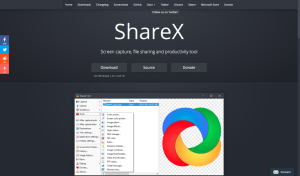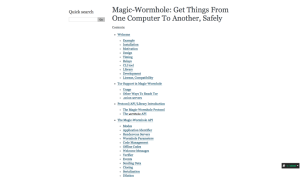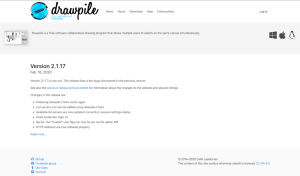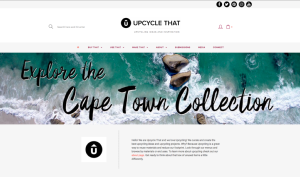Theme: Remote Work Tools
Back to Top
|
 |
|
Etherpad
|
Science |
|
|
Real-time and all online, Etherpad is a great tool for smooth, remote collaborating. Last featured in the 09-14-2018 Scout Report, the platform was most recently updated in December 2019 to improve security and ease of use.
Etherpad is a web-based real-time collaborative editor. Any user can create a collaborative document, called a "pad," each of which has a distinct URL. Anyone that has this URL can make edits to the pad, with every editor's changes appearing in their own color. Etherpad automatically saves changes periodically, but users may also checkpoint specific versions at any time. The editing history of each pad is also saved, with a slider allowing users to rewind a document to view previous versions. Pads can be downloaded in plain text, HTML, PDF, ODF, or Word format. A number of free, public Etherpad servers are available. These can be located in the "List of public instances" under the Links section of the Etherpad site. For users that wish to self-host an Etherpad instance, server installers are provided on the Etherpad site for Windows, macOS, and Linux. Etherpad is distributed under the Apache 2.0 license, with source code available on GitHub. [CRH]
|
|





|
|
 |
|
 |
|
ShareX
|
Science |
|
|
ShareX (featured in the 07-27-2018 Scout Report) continues to be a popular tool for sharing screenshot and screencast information. Since the release of the latest version in March 2020, this tool has been downloaded more than 500,000 times.
Easily share screenshots and screencasts with co-workers through ShareX, a Windows utility for capturing and sharing this information. The resource provides a number of ways to specify what should be captured. Users can select from everything on all displays, a single display, a single window, a single region of a window, and other capture modes. Once an image or movie is captured, ShareX can perform a number of post-processing tasks, including watermarking and text recognition. Completed screenshots/screencasts can be uploaded to one of several dozen services. Links to the uploaded file can be created with a variety of URL shorteners (bit.ly, is.gd, tinyurl.com, and others). Lastly, these links can be shared using a number of social media channels, including Twitter, Facebook, Google+, and Reddit. ShareX is licensed under the GNU General Public License version 3, with source code available on GitHub. Executables can be downloaded for Windows computers. ShareX requires Windows 7 or newer. [CRH]
|
|





|
|
 |
|
Magic Wormhole
|
Science |
|
|
Last featured in the 11-22-2019 Scout Report, Magic Wormhole's mission to "get things from one computer to another safely," is even more important in remote work environments.
Magic Wormhole is a command-line tool for moving arbitrarily sized files or folders from one computer to another securely, without storing them on an intermediate server (e.g. Dropbox). It is designed primarily for situations where two users are already talking and need to exchange a file. To use Magic Wormhole, a sender issues a command such as wormhole send FILE and is given a "wormhole code" derived from a short, pronounceable, phonetically-distinct word list. The sender must then relay this code to the recipient. When the recipient runs wormhole, receives, and enters the provided code, the two computers locate each other via a public "Rendezvous Server," establish a secure connection via Password-Authenticated Key Exchange, and transfer the specified data. Detailed API and protocol documentation describing exactly how this works are provided on the Magic Wormhole site. In the Installation portion of the site, users can locate installation instructions for macOS, Linux, and Windows computers. Magic Wormhole is distributed under the MIT license, with source code available on GitHub. [CRH]
|
|





|
|
 |
|
Drawpile
|
Arts |
|
|
Those in creative fields (such as graphic design and marketing) may be searching for work-from-home collaboration tools designed to share more than text. Drawphile (featured in the 09-28-2018 Scout Report) provides just that: a collaborative image-editing platform. In February 2020 Drawphile released an updated version, correcting a few previous bugs.
Drawpile is a network-enabled drawing program that allows multiple users to simultaneously edit the same image. In the servers section, users can find a list of active public sessions and may create their own drawing sessions (either fully open or password protected) on the public Drawpile server. The Drawpile application also includes a built-in server that can host collaborative drawing sessions that are accessible to other users on the same network. A number of functions for managing sessions are provided (for example, kicking/banning problematic users); the full list is described in Collaboration and User Management in the About section of Drawpile's website. Drawpile can also create animations, either by recording a whole drawing session as a video file or by using image layers as frames. Images are exported in OpenRaster format, which can be imported by applications like MyPaint, Krita, or GIMP. Drawpile executables can be downloaded for Windows, macOS, and Linux. Drawpile is free software, distributed under the GNU General Public License version 3, with source code available on GitHub. [CRH]
|
|





|
|

















